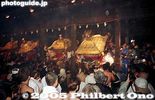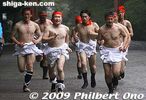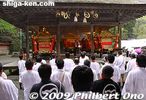Sanno-sai Festival 山王祭
|
Title   • File Name • File Name   • Date • Date   • Position • Position   |
|

The Sanno-sai Festival is held annually on April 12-15 at Hiyoshi Taisha Shrine in Otsu, Shiga Prefecture. Not to be confused with the Sanno Matsuri held by Hie Shrine in Tokyo. It centers on April 14, the shrine's most important day called Reisai.
|
|

Hiyoshi Taisha is at the foot of Mt. Hiei (home of Enryakuji temple) and it worships the mountain god. The Sanno-sai festival is the shrine's biggest festival and one of Shiga's biggest festivals. MAP
|
|

On April 12, they raucously bring down portable shrines from Mt. Hachioji nearby in the evening. On April 13, they hold a series of ceremonies including this one called the Tea Offering Ceremony at 11 am. 献茶祭
|
|

Hiyoshi Taisha's tea field is said to be Japan's oldest. Tea picked from this field is presented to the gods housed in the portable shrines.
|
|

The Tea Offering Ceremony is held at the Yomiya-jo where the four portable shrines (mikoshi) are placed. 宵宮場 大政所
|
|

Delivering the tea.
|
|

Delivering the tea.
|
|
|

The tea is offered to each of the four mikoshi which had been brought down from Mt. Hachioji the night before. The tea is said to bring safe childbirths.
|
|

These photos were taken on April 13-14, 2009. I still have to see the other ceremonies.
|
|

After the Tea Offering Ceremony, they march back.
|
|

The Sanno Festival (in Japanese it's called Sanno-sai, not Sanno Matsuri) consists of a myriad of festival events. Also interesting is the participation of Buddhist priests from Enryakuji temple atop Mt. Hiei.
|
|

The four mikoshi at the Yomiya-jo storehouse.
|
|
|
|

Monkey carvings on a mikoshi. The monkey is the messenger of the mountain god.
|
|

At 1 pm on the Sando main road leading to Hiyoshi Taisha Shrine, the Flower Procession (Hana-watari-shiki) is held with little kids dressed up as nobility.
|
|

The procession includes samurai.
|
|

Flower Procession draws large crowds.
|
|

Spectators come to see their classmates in the procession.
|
|

Flower Procession on Sando 花渡り式
|
|
|

Flower Procession. They walk slowly and deliberately with parents and relatives in tow. 花渡り式
|
|
|
|
|
|
|

Flower Procession, Sanno-sai Festival. There are two escorts wearing ceremonial aprons and they drag a wand over the road.
|
|
|
|

Little kids in ceremonial dress for this fesival are called chigo. 稚児
|
|
|

THe Flower Procession is held to celebrate the birth of the shrine's child god. Therefore, this event centers on the parent-child connection.
|
|

Some kids get tried and end up being carried.
|
|
|

The Flower Procession ends at the Yomiya-jo where they bless the child in front of the mikoshi. This Flower Procession ceremony costs the proud, doting parents big bucks.
|
|

Family portrait with the chigo child.
|
|

Samurai warriors in the Flower Procession.
|
|
|

Hi kids!
|
|
|

The next ceremony is the Hitsuji Offering Ceremony conducted by parishioners from Hiyoshi Jinja Shrine in Kyoto. Starting at 3 pm on April 13, this ceremony has been conducted for many centuries since the Heian Period. 未の御供献納祭
|
|
|

The offerings are given to the four mikoshi at the Yomiya-jo storehouse.
|
|

Afterward, they move to Hiyoshi Taisha's Nishi Hongu Shrine.
|
|

Hiyoshi Taisha's Nishi Hongu (West) Shrine. This building is a National Treasure. 西本宮
|
|

Assistants stand on the steps of the Nishi Hongu.
|
|

The Hitsuji offerings include arrows, bells, brushes, dolls, flowers, and sweets. Priests give prayers as they deliver the offerings.
|
|

Young ceremony assistants.
|
|

April 13 climaxes in the evening with the Yomiya Otoshi Ceremony starting with a torch procession around the streets near Hiyoshi Taisha from 6 pm.
|
|

Shrine parishioners carry giant torches around the streets of Sakamoto the neighborhood of Hiyoshi Taisha.
|
|
|
|
|
|

Shogenji temple where all the torch bearers will gather later. Shogenji is a Tendai Buddhist temple on the Sando road. 生源寺
|
|

The torch procession gather at Shogenji temple at 7 pm on April 13.
|
|

All the torch groups head for the temple.
|
|

These guys can get pretty drunk as they haul the torches.
|
|

Now at the Yomiya-jo where the four mikoshi are placed. The torch bearers run from the Sando road to Yomiya-jo. This is at around 9 pm.
|
|

The first group arrive at Yomiya-jo and go to their mikoshi.
|
|
|
|
|

The first group start to violently rock the mikoshi back and forth.
|
|

Another group arrive and position themselves at another mikoshi.
|
|

Two more groups arrive while running.
|
|

Torch bearers arrive at the Yomiya-jo while running.
|
|
|

All four groups have arrived and they stand around the mikoshi. There are more people behind the mikoshi as well.
|
|

Yomiya-jo
|
|

All four groups of men then rocked the mikoshi back and forth. making thunderous noise. Very dramatic. This is called Yomiya Otoshi. 宵宮落し神事
|
|

They stop and after a few speeches, they drop the mikoshi with a bang to symbolize the birth of the child god. Also see my YouTube video here.
|
|

The fun is not over until they start to carry the mikoshi out of the Yomiya-jo. They run with the mikoshi and make it very dramatic (and dangerous if you're in their way).
|
|

There they go, racing to Nishi Hongu Shrine. And that's it for April 13.
|
|

Next day on April 14, the Reisai day, the schedule is filled with more ceremonies and events. At 10 am, the Reisai ceremony is held at Nishi Hongu with the Tendai Zasu Abbot from Enryakuji in attendance. He is under the red umbrella.
|
|

The Tendai Abbot (orange robes) lines up along with other Enryakuji Buddhist priests on the Sando path of Hiyoshi Taisha.
|
|

THe head priest of Hiyoshi Taisha greets the Tendai Abbot.
|
|
|

The Shinto priests proceed to Nishi Hongu.
|
|

It was raining this day on April 14, 2009. This is the Romon Gate to Nishi Hongu.
|
|

The Tendai Zasu Abbot proceeds to Nishi Hongu.
|
|

More Tendai priests from Enryakuji temple proceed to Nishi Hongu. Buddhist priests do not wear the flappy cap like Shinto priests.
|
|

More bowing between priests.
|
|

Interesting to see Buddhist priests chanting Buddhist sutras in front of a Shinto shrine.
|
|

Evidence of how close Shinto and Buddhism were in past centuries in Japan.
|
|

On the left is the Haiden Hall with the mikoshi which were brought there the night before from the Yomiya-jo. Nishi Hongu's Honden (main hall) is on the right. 例祭
|
|

The Tendai Zasu Abbot is escorted to the Honden.
|
|

Tendai Zasu Abbot 天台座主
|
|

The Tendai Abbot chants a sutra in front of the Honden at Nishi Hongu. 読経
|
|

The Tendai Abbot receives the sacred branch to be offered at Nishi Hongu.
|
|
|
|

The Tendai Abbot offers the sacred branch.
|
|

Ceremony attendees.
|
|
|

Nishi Hongu Haiden Hall has the mikoshi portable shrines.
|
|
|

After the Reisai Ceremony, the Tendai Abbot leaves Nishi Hongu through the Romon Gate.
|
|
|

The Tendai Abbot leaving Nishi Hongu.
|
|

The Tendai Abbot leaves Nishi Hongu in a procession of Buddhist priests.
|
|

Mikoshi bearers on Sando road make their way to the shrine.
|
|
|

Festival participants make their way to the shrine.
|
|

Mikoshi bearers run to the shrine.
|
|
|

Mikoshi bearers run through Nishi Hongu's Romon Gate.
|
|

Sacred Horse (dummy) on a small truck proceeds around the shrine at 1 pm. I wonder how they did this in the old days. 御浦神事
|
|

People head for Nishi Hongu where the mikoshi are.
|
|
|

Returning the large sakaki branch from Tenson Shrine. 大榊還御
|
|
|
|
|

At 1 pm, they held the Large Sakaki Branch Returning Ceremony at Nishi Hongu. The branch was returned from Tenson Shrine (天孫神社/西宮神社). Sakaki is a type of evergreen sacred to Shinto. 大榊還御
|
|

After the sakaki branch ceremony, at 1:30 pm they held the Haiden Departure Ceremony at the Haiden where seven mikoshi were placed. 拝殿出し神事
|
|

They then carried the mikoshi from the Haiden to the Sando road.
|
|

They passed through the Romon Gate.
|
|

Carrying the mikoshi through Romon Gate at Nishi Hongu.
|
|
|

It was done with great fanfare.
|
|

One after another, they carried out the seven mikoshi.
|
|
|
|

Mikoshi ornaments were then installed on the mikoshi.
|
|

Three of the mikoshi were put on trucks.
|
|

Ceremony in front of a shishi lion head.
|
|

Four of the mikoshi were to be carried by humans.
|
|

At 2:30 pm, they started carrying the mikoshi.
|
|
|

The mikoshi pass under the Sanno torii.
|
|

Sanno-sai Festival, Hiyoshi Taisha Shrine, Otsu, Shiga Prefecture
|
|

Sanno-sai Festival, Hiyoshi Taisha Shrine, Otsu, Shiga Prefecture
|
|
|

神輿神幸
|
|

Heading down Sando road.
|
|
|
|

Passing under another torii facing Sando road.
|
|

Sanno-sai Festival, Hiyoshi Taisha Shrine, Otsu, Shiga Prefecture
|
|
|
|
|

Mikoshi on trucks to transport them to the boat dock.
|
|

Mikoshi bearers are taken by bus to the boat dock at 七本柳の浜 which was too far away for me to reach in time.
|
|

Hiyoshi Taisha torii on the shore of Lake Biwa. This is not where they load the boat with the mikoshi.
|
|

The mikoshi departed by boat at 3 pm. They were put on a barge pulled by a tugboat. The barge sailed off the coast of Karasaki Shrine where they held a ceremony.
|
|

Then the mikoshi sailed to Wakamiya Port. 船渡御
|
|

Barge loaded with mikoshi approaching Wakamiya Port. Sanno-sai Festival.
|
|

The mikoshi return to land at Wakamiya Port.
|
|
|
|
|

Mikoshi bearers were standing by at Wakamiya Port and one by one they offloaded the mikoshi from the barge.
|
|
|
|
|

They carried the mikoshi on a rainy day on April 14, 2009.
|
|

Wakamiya Shrine near Wakamiya Port.
|
|
|
|
|